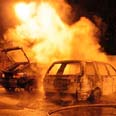
French Lessons for Israel
Israel should heed warning of what social, economic inequalities can precipitate
Almost immediately after France’s angry and disenchanted youth of largely North African descent began rioting in the suburbs of Paris and other cities, Israeli and Jewish press began running special sections and headlines heralding the arrival of a French or Parisian intifada.
The implication was clear. Any outbreak of civil unrest involving Arab or Muslim youth is analogous to the violent uprising Palestinians have waged on Israel for the last five years and, before that, in the late 80s.
There definitely is a connection between the difficult situation France is now facing and the reality in Israel today. But it has little to do with the knee-jerk reaction displayed by many Israeli papers and is far too important to be brushed aside with sensational coverage.
While Islam may complicate France’s problems, the situation it faces says more about the West than the Orient. Writing in The New York Times, and convincingly brushing aside a focus on the rioters’ religious orientation, French scholar Olivier Roy instead noted that “we are dealing here with problems found by any culture in which inequities and cultural differences come in conflict with high ideals. The struggle to integrate an angry underclass is one shared across the Western world.”
Violent rioting not limited to Israel’s non-Jews
Unfortunately, if there is any country that should heed the warning of what social and economic inequalities with cultural overtones can precipitate, it is Israel. While tensions between the country’s Ashkenazi elite and largely working class Mizrahi have long existed, the Jewish state faces even more daunting challenges today: Growing economic disparity and two large and alienated minority populations - Arab and Ethiopian - who have already displayed discontent with their integration into Israeli society.
“Income inequality in Israel has risen over the past three decades, and Israel is now one of the countries with the widest economic disparities,” according to a study on social rights and economic policy by the Israel Democracy Institute.
The study goes on to note that the “dire economic plight” of the Arab population, which it says stems partly from discrimination in education and the labor market, is one of the main sources of income inequality.
The Abraham Fund reports that average wages are 40 percent lower for Arab citizens, infant mortality is twice as high, and while Arabs comprise 18 percent of the population, they only account for 5 percent of Israeli college graduates.
Such statistics led Israel’s Or Commission to determine that anger and resentment over ongoing discrimination in these and other sectors helped fuel violent demonstrations by Israeli Arabs after the intifada’s outbreak in 2000 - which left 13 demonstrators dead.
But violent rioting has not been limited to Israel’s non-Jews. In 1996, some 10,000 Ethiopian Jews demonstrated outside the Prime Minister's Office in Jerusalem after blood they had donated was discarded by blood banks for fear that Ethiopian blood was more likely to carry the HIV virus.
Soul searching and ingenuity
Although the scandal touched off the rioting, the demonstrations quickly transformed into a broader forum on race with the protesters addressing what they perceived as widespread discrimination against black Jews in Israeli society. Nearly 10 years later, both veteran Ethiopian Israelis and new immigrants continue to live in the country’s figurative and literal periphery, settled in the poorest neighborhoods of a few cities.
An Adva Institute study on Ethiopian Israelis recently found that 47 percent of those between the ages of 25–54 are not part of the labor force, 72 percent of children live in households below the poverty line and 6.2 percent of high school aged children drop out of the education system (compared with 3.5 percent of the population as a whole).
Having pledged to bring Ethiopia’s remaining 15,000 Falas Mora home over the next few years, eventually raising the Ethiopian-Israeli population to roughly 100,000, Israel needs to focus on alternative plans for integration before a semi-permanent minority underclass is created.
Like France, Israel will have to engage in a combination of soul searching and ingenuity if it’s to close the gap that exists between the state’s lofty ideals and humbling reality. The plain truth is unless both countries can provide national identities and social equalities that are relevant to their increasingly diverse and assertive populations each will face many more riots in the future.
C’est la vie.
Jason Gitlin, a graduate of NYU's Center for Near Eastern Studies, is a New York-based writer










